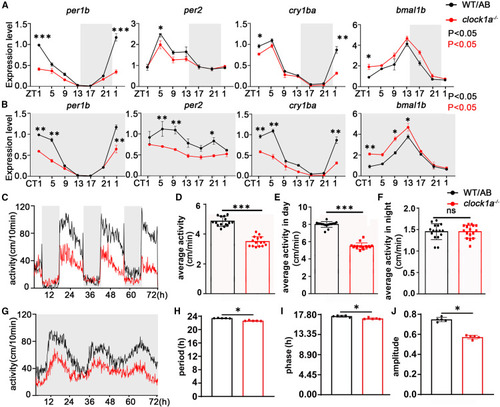Fig. 2
- ID
- ZDB-FIG-240205-32
- Publication
- Chen et al., 2023 - Circadian clock1a coordinates neutrophil recruitment via nfe212a/duox-reactive oxygen species pathway in zebrafish
- Other Figures
- All Figure Page
- Back to All Figure Page
|
Clock1a plays roles in the zebrafish circadian clock (A and B) Zebrafish embryos were raised in LD conditions for 4 consecutive days and then tested in LD and DD conditions at 5 dpf. Total RNA was extracted from WT and clock1a mutant larvae at 4-h intervals for 24 h under LD and DD conditions. qPCR analysis showed that the amplitudes of key circadian clock genes per1b, per2, and cry1aa were decreased in clock1a mutant fish, but the amplitude of the bma1b gene was increased under both DD and LD conditions. The experiment contained three samples. Each sample contained 50 larvae. The genes were expressed relative to β-actin. The rhythmic mRNA expression was analyzed by the JTK-CYCLE method. Two-way ANOVA was used to analyze the variation between different groups. (C and G) The locomotor activity of clock1a mutant and WT larvae was tested beginning at 5 dpf under LD and DD conditions (n = 24, each group). (D–F) Under LD conditions, the average movement speed of clock1a larvae was significantly decreased during the 24-h period and (E) during the daytime (F) but not at night. Data were analyzed with unpaired t tests. (H–J) Under DD conditions, (H) the movement period and (J) amplitude were decreased and (I) the phase was advanced in clock1a larvae. Data were analyzed with unpaired t tests. All experiments were repeated three times, and the results show the data from an independent experiment. Bar graphs represent the mean ± SEM (∗p < 0.05; ∗∗p < 0.01; ∗∗∗p < 0.001). |

